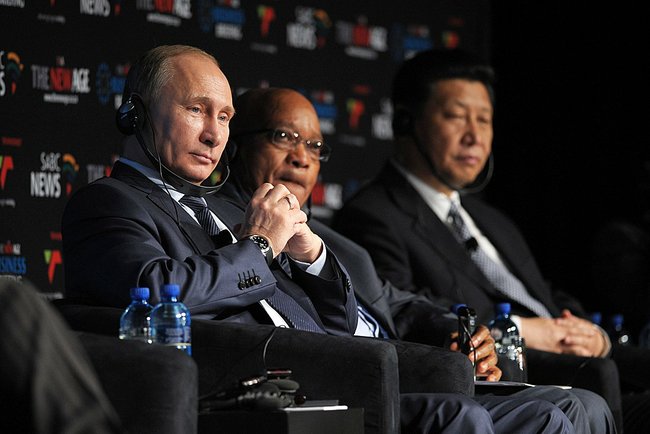

Follow us on:  
|


File photo: Russian President Vladimir Putin (left) with his South African counterpart Jacob Zuma and Chinese President Xi Jinping (right) at the 5th BRICS Summit on 27 March 2013 in Durban, South Africa [PPIO]
The African Regional Centre of the New Development Bank (NDB) was launched by South African President Jacob Zuma on Thursday in Johannesburg.
The African Regional Center will allow countries in the continent to have access to the $100 billion NDB.
“This is a critical milestone not only for South Africa but the African continent as a whole,” Zuma said adding that “the NDB will grow from strength to strength”.
“We expect the NDB through the Regional Centre to contribute to energy and other productive sectors,” Zuma added.
The NDB headquarters were officially opened in Shanghai, China in February 2016.
The new lender is expected to strengthen the group’s ability to offer developing nations the support traditionally given by the US and Japan through organizations like the World Bank.
On Thursday, the African unit of the BRICS Bank was launched with President of the NDB, Kundapur Vaman Kamath, members of the South African cabinet, including Finance Minister Malusi Gigaba and South African Foreign Minister Maite Nkoana-Mashabane in attendance.
The President of the NDB said the “establishment of the African regional centre is a milestone for the NDB”.
“In 2018, the NDB expects to present about 20 projects,” Kamath said in Johannesburg on Thursday.
The BRICS’ increasing projection of influence in Africa is reconfiguring global geopolitics, aiding south-south cooperation, which seeks to achieve greater autonomy from the west. BRICS members China and India have strong economic and trade ties with the African continent. China-Africa trade, for instance, grew from $10 billion in 2000 to $220 billion in 2014.
On Thursday, South Africa’s Science and Technology Minister Naledi Pandor said South Africa has worked with BRICS partners in support of the continental agenda.
Last week, former governor of the South African Reserve Bank Tito Mboweni was removed as a non-executive director of the BRICS New Development Bank after serving a two-year term. Mboweni was replaced by South Africa’s National Treasury director-general, Dondo Mogajane.
The New Development Bank came into existence after three years of negotiations among members of BRICS.
The BRICS Bank has 23 projects at various stages of preparation for 2017 to 2018, with a total lending amount of $6 billion, NDB President K.V. Kamath said at a press conference last month in Shanghai.
In 2016, the bank granted $1.5 billion in loans to seven projects.
The bank has an initial authorized capital of $100 billion.
Its initial subscribed capital of $50 billion will be equally shared among the founding members.
It has a three-tier governance structure — a board of governors, a board of directors, a president and vice presidents.
The new lender hopes to get rated by international rating companies by the end of the year. According to the NDB, Standard Chartered and Goldman Sachs have been chosen to be bank’s advisers for international ratings.
A recent Bloomberg report said emerging-market investors are again piling into the BRICS markets, pushing monthly inflows and stock prices to nearly two-year highs.
Non-resident portfolio flows into BRIC nations rose to $166.5 billion in May, up from $28.3 billion in outflows 12 months prior, according to data compiled by the Institute of International Finance and EPFR Global.
Financing sustainable development and infrastructure projects and local currency financing remain the focus of the New Development Bank launched by the BRICS countries, according to a new policy document for the next five years.
The new lender has said it plans to expand membership gradually.
“NDB signifies developing countries’ coming of age and reflects their aspirations to stand on their own feet,” according to the 2017-2021 strategy document.
BRICS members, China, India and Russia are also the three largest shareholders in the China-led Asian Infrastructure Investment Bank (AIIB).
Both the BRICS Bank and the AIIB will extend China’s financial reach and compete not only with the World Bank, but also with the Asian Development Bank, which is heavily dominated by Japan.
TBP